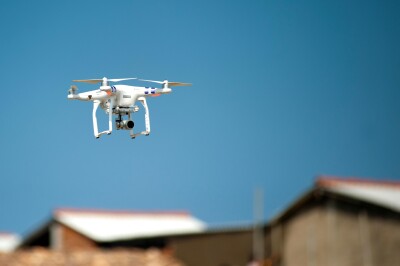Last week’s Imaging and LiDAR Solutions Conference in Toronto, held by the newly minted Teledyne Optech, hosted a full afternoon of presentations about drones. Most surprisingly for this reporter, having followed the UAV industry closely for more than a year already, the presentations felt fresh. There are a lot of possible uses for the technology, and just when you think you’ve heard them all, someone proves you wrong. A UAV Tethered to an SUV?The most surprising presentation was given by Pere Molina, the advanced applications program manager at GeoNumerics. He presented on the mapKITE project, which his company is coordinating to develop “a tandem terrestrial-aerial system for high-resolution corridor mapping.”
mapKITE’s aerial system consists of a UAV equipped with remote sensors and autopilot. The terrestrial system consists of a car or other moving vehicle with its own sensors and a real-time navigation system.
These two systems work together: The mobile portion, loaded up with higher quality systems, computes a real-time trajectory for the UAV. It sets waypoints for the UAV by converting the information from the mobile sensors into information about height and heading for the UAV to follow. The team calls it a virtual tether that pulls the UAV behind the mobile mapping vehicle. Hence: a map kite.
Clever, and it seems perfect for utilizing drones for mapping corridors or performing pipeline inspection, power inspection, and so on. Urban areas still present a challenge.
As it shakes out, this arrangement means a number of things. First, this means that the mapKITE would allow you to combine two different data sets, one gathered by car and one by drone, each with their benefits and weaknesses. And mapKITE promises lower cost than performing the two surveys separately.
Second, it also means that you couldn’t use it in the US because of FAA rules that against a moving operator. Even if you wanted to, the system makes heavy use of European GNSS, so it might not work to your standards in the US. Sorry, Americans.
Molina, of course, was swamped with questions after his presentation.Joining ForcesIn his presentation, Martin Herkommer of Geo-Konzept dug deeper into the ways that mobile or terrestrial and unmanned drone mapping technologies are complementary technologies.
Each tool has its own unique advantages and disadvantages. The terrestrial scanner produces very high quality deliverables, but there are only so many places where you can safely position it. The ground has to support a tripod, the area has to allow safe access on foot, etc. This means that you will find scan shadows, or occlusions in your scan–areas that the light from the scanner was simply not able to reach.
A UAV equipped with simple photogrammetric equipment can get at a lot of those areas that the terrestrial scanner can’t. However, it often misses vertical surfaces and produces a less precise deliverable.
Herkommer uses the two technologies together in a way that gets the best of both worlds. He performs a basic terrestrial survey, making sure to cover areas of interest and areas where a UAV would miss. Next, he performs a UAV survey of the whole site. During post-processing, he simply combines the two data sets, discarding the aerial data “where it conflicts with the more precise TLS data.” Essentially, he uses that aerial data only to fill in the gaps.
He then merges that 3D data with the original unmanned aerial vehicle photography. The result is an “accurate, complete, and colorized 3D map of the survey area.”
Herkommer claims that the process saves a significant amount of time when surveying complex areas. It does, after all, reduce greatly the number of terrestrial scans that need to be performed in order to achieve good coverage. He also told the audience that it collects better data than either the UAV or the terrestrial scanner could manage on their own, and for much less money.
He showed us a case study of a project he completed in Gibraltar. The scan included some pretty large peaks, and a lot of vertical faces. The data sets combined beautifully to give a full survey. He also showed a video collected on a second trip to Gibraltar for surveying. The team collected terrestrial scans of points where more detailed analysis would be performed, and covered the rest with a photogrammetric UAV survey. The results were gorgeous and exactly what was needed.
The combination of these two technologies, he said in what felt like a moment of understatement, have proven to be particularly efficient and flexible. He was also swamped with questions after his presentation.
(A drone “fun fact” from Herkommer’s presentation: Seagulls will avoid a drone, at least at first. See the 30m berth they’re giving it? However, Herkommer said he spoke to an airfield employee nearby who thinks that, given enough time, the seagulls would become curious and get a little too close.)
A UAV Tethered to an SUV?The most surprising presentation was given by Pere Molina, the advanced applications program manager at GeoNumerics. He presented on the mapKITE project, which his company is coordinating to develop “a tandem terrestrial-aerial system for high-resolution corridor mapping.”
mapKITE’s aerial system consists of a UAV equipped with remote sensors and autopilot. The terrestrial system consists of a car or other moving vehicle with its own sensors and a real-time navigation system.
These two systems work together: The mobile portion, loaded up with higher quality systems, computes a real-time trajectory for the UAV. It sets waypoints for the UAV by converting the information from the mobile sensors into information about height and heading for the UAV to follow. The team calls it a virtual tether that pulls the UAV behind the mobile mapping vehicle. Hence: a map kite.
Clever, and it seems perfect for utilizing drones for mapping corridors or performing pipeline inspection, power inspection, and so on. Urban areas still present a challenge.
As it shakes out, this arrangement means a number of things. First, this means that the mapKITE would allow you to combine two different data sets, one gathered by car and one by drone, each with their benefits and weaknesses. And mapKITE promises lower cost than performing the two surveys separately.
Second, it also means that you couldn’t use it in the US because of FAA rules that against a moving operator. Even if you wanted to, the system makes heavy use of European GNSS, so it might not work to your standards in the US. Sorry, Americans.
Molina, of course, was swamped with questions after his presentation.Joining ForcesIn his presentation, Martin Herkommer of Geo-Konzept dug deeper into the ways that mobile or terrestrial and unmanned drone mapping technologies are complementary technologies.
Each tool has its own unique advantages and disadvantages. The terrestrial scanner produces very high quality deliverables, but there are only so many places where you can safely position it. The ground has to support a tripod, the area has to allow safe access on foot, etc. This means that you will find scan shadows, or occlusions in your scan–areas that the light from the scanner was simply not able to reach.
A UAV equipped with simple photogrammetric equipment can get at a lot of those areas that the terrestrial scanner can’t. However, it often misses vertical surfaces and produces a less precise deliverable.
Herkommer uses the two technologies together in a way that gets the best of both worlds. He performs a basic terrestrial survey, making sure to cover areas of interest and areas where a UAV would miss. Next, he performs a UAV survey of the whole site. During post-processing, he simply combines the two data sets, discarding the aerial data “where it conflicts with the more precise TLS data.” Essentially, he uses that aerial data only to fill in the gaps.
He then merges that 3D data with the original unmanned aerial vehicle photography. The result is an “accurate, complete, and colorized 3D map of the survey area.”
Herkommer claims that the process saves a significant amount of time when surveying complex areas. It does, after all, reduce greatly the number of terrestrial scans that need to be performed in order to achieve good coverage. He also told the audience that it collects better data than either the UAV or the terrestrial scanner could manage on their own, and for much less money.
He showed us a case study of a project he completed in Gibraltar. The scan included some pretty large peaks, and a lot of vertical faces. The data sets combined beautifully to give a full survey. He also showed a video collected on a second trip to Gibraltar for surveying. The team collected terrestrial scans of points where more detailed analysis would be performed, and covered the rest with a photogrammetric UAV survey. The results were gorgeous and exactly what was needed.
The combination of these two technologies, he said in what felt like a moment of understatement, have proven to be particularly efficient and flexible. He was also swamped with questions after his presentation.
(A drone “fun fact” from Herkommer’s presentation: Seagulls will avoid a drone, at least at first. See the 30m berth they’re giving it? However, Herkommer said he spoke to an airfield employee nearby who thinks that, given enough time, the seagulls would become curious and get a little too close.)
Subscribe
The information you submit will be stored and used to communicate with you about your interest in Commercial UAV News. To understand more about how we use and store information, please refer to our privacy policy.
June 16, 2015
UAV + Terrestrial Scanning = Best of Both Worlds















Comments